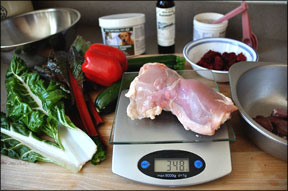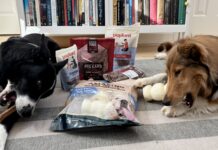Over the past few months, I’ve read more than 30 books on homemade diets for dogs. Many offered recipes that were dangerously incomplete; a smaller number provided acceptable guidelines but were confusing, unduly restrictive, overly complicated, or had other issues that made me recommend them only with reservations. A few were good enough to recommend without reservation.

This review is about the cream of the crop: three relatively new books (or new editions of an older book) whose authors have taken the time to analyze their recipes to ensure that they meet the latest nutritional guidelines established by the National Research Council (NRC). All three books offer boneless recipes as well as some that include raw meaty bones (RMBs), giving you the option of choosing either style of feeding, or a combination of the two, depending on what works best for both you and your dogs.
These three books take an approach that’s very different from the books that focus on just raw meaty bone diets, which I reviewed in December (“Reliable Guides for Raw Diets”). Those books provided dietary guidelines rather than recipes, relying on common sense and mimicking the evolutionary diet of the wolf rather than nutritional analyses to provide diets that are complete and balanced. I believe such an approach is valid and follow it myself, but the guidelines are often misinterpreted, leading to diets that are missing critical ingredients or overloaded with others, and thus nutritionally unbalanced and incomplete.
The books reviewed also differ from the boneless diet books I reviewed in the January issue (“No Bones About It”): none of those books provided recipes that had been analyzed to ensure that they met NRC guidelines. The best of those books gave good guidelines for creating a complete homemade diet, but each required careful attention to the text to ensure that nothing was left out. People who just follow the recipes are likely to end up feeding an incomplete diet.
The three books included in this review are quite specific about what you should feed and what supplements you need to add. They offer peace of mind for those concerned that the diet they’re feeding may not meet all of their dog’s nutritional needs. They provide a reliable alternative for those who are not able to feed, for whatever reason, the wide variety of foods needed to provide a complete and balanced diet without supplementation. They offer help to people whose dogs are experiencing health problems that could be related to their diet. And for those of us who just want to understand more about where essential nutrients come from in the diets that we feed, and what might be missing, the information they provide is fascinating.
Two of these books provide recipes that meet requirements for all life stages, while the third can be used for adult maintenance only. It’s important to pay attention to this factor when you’re looking for books to help you feed your puppy or pregnant or nursing female.
I can’t recommend these books highly enough, not only for those interested in starting their dogs on a homemade diet, but also for people who already feed one. Reading through them has made me look more carefully at the diet I feed my own dog and the dietary guidelines that I give others, particularly regarding supplements. When I’m done with the book reviews, I plan to write about the changes I’m making based on what I’ve learned from these books.
A new approach
Two books published fairly recently include recipes for both boneless and raw meaty bones (RMB) meals. These two books have similarities, as the authors have worked together in the past and relied on much of the same research. Both are particularly appropriate for those concerned that their homemade diets meet NRC guidelines, as all recipes have been designed and analyzed to ensure that they do.
These are the only homemade diet books that address the issue of balanced fats, going beyond the ratio of omega-6 to omega-3 fatty acids. Modifying fats may be beneficial for dogs with skin problems and other inflammatory conditions. Both books stress feeding lean meats, which they recommend feeding raw, but light cooking is acceptable for boneless meat. Both also advise using bone meal, or other supplements that combine calcium and phosphorus such as MCHC or dicalcium phosphate, rather than plain calcium to balance the boneless recipes. The extra phosphorus is needed to meet requirements for puppies, as the recipes are designed for all life stages.
Both books omit dairy products and grains (except for one recipe with a small amount of oat bran in Brown’s book), and limit the amount of starchy vegetables. This can be beneficial for some dogs, particularly those prone to weight gain or inflammation from health issues such as allergies and arthritis. Carbohydrates, however, reduce the cost of a homemade diet. Those with large dogs who do not feed RMBs (which are usually less expensive than muscle meats) may find these diets cost-prohibitive. Very active dogs and females used for breeding can also benefit from more carbohydrates in the diet.
The winners are:
1. Dr. Becker’s Real Food for Healthy Dogs & Cats is the perfect book for those who want simple, clear recipes that meet NRC and AAFCO requirements for both puppies and adult dogs. I loved the 2009 edition that I originally read, but I’ve also had a chance to preview the 3rd edition and it’s even better. The basic recipes are the same, but the new edition provides many more details, including nutritional analyses of all recipes. The authors still recommend feeding all of the foods in their original recipes, but the new edition offers options for omitting certain foods, telling you what additional supplements need to be provided in those cases.
2. For those who really want to understand the whys and wherefores of homemade diets, Unlocking the Canine Ancestral Diet is ideal. Author Steve Brown delves into the ancestral diet of the dog and compares it to the latest NRC guidelines. Brown is the creator of Steve’s Real Food for Dogs (he no longer owns the company) and See Spot Live Longer Homemade Dinner Mixes. Step by step, he investigates the nutrients supplied by different foods, and how to go about combining those foods to achieve balanced meals that meet NRC guidelines without the use of synthetic supplements (he adds vitamin E and also includes bone meal in recipes that don’t include bone). Particular attention is paid to ensuring that fats are properly balanced, going beyond the ratio of omega-6 to omega-3.
3. Monica Segal’s book, K9 Kitchen, offers guidelines and sample recipes for diets based on raw meaty bones, cooked diets, and combinations of the two. Segal’s moderate approach encourages you to pick the style of feeding that you’re most comfortable with and that works for your dog. Sample weekly recipes for all three styles of feeding are included for dogs of various weights and activity levels.
Much more information about these books – their strengths and weaknesses, as well as their prices, length, and where you can find them – can be found in the March issue of WDJ, A Review of the Best Books on Home-Prepared Dog Food Diets on the Market.
Mary Straus investigates canine health and nutrition as an avocation. She is the owner of the DogAware.com website. She and her Norwich Terrier, Ella, live in the San Francisco Bay Area.






